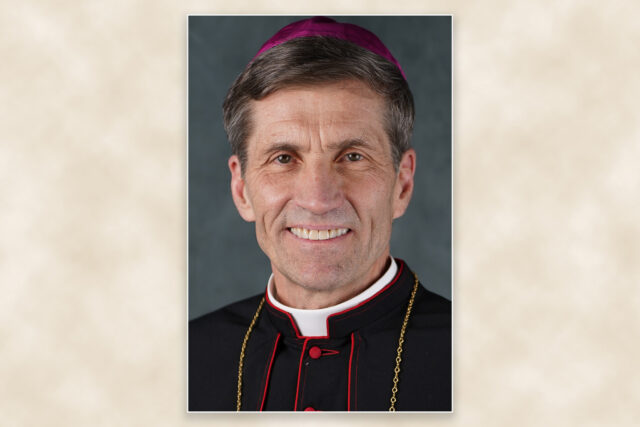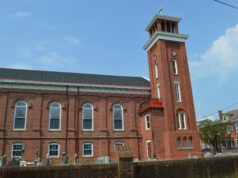Easter 2024
Dear Brothers and Sisters in Christ,
The Gospel of Mark that is proclaimed at this year’s Easter Vigil, tells the story of three women going early in the morning to the tomb where Jesus’ body has been laid to rest. Their desire to anoint the body of Jesus is a laudable one. There is, however, a huge stone blocking the entrance to the tomb and so the ability to accomplish their goal would seem far beyond the realm of possibility. And yet the women are undeterred and simply ask, as they approach the tomb: “Who will roll back the stone for us from the entrance to the tomb?” The question is answered, St. Mark tells us in the very next verse: “they looked up [and] they saw that the stone had been rolled back.” And so began the story of the Resurrection of Christ and the power of God that did not just roll back a stone from the entrance to a tomb but rolled away the stone of death and sin that had blocked us from entrance into eternal life.
The story of the early church does not end, however, with the “news flash” that Jesus has

risen to new life and that the disciples can now return to life as it was lived before Jesus. Rather, the picture that emerges after Jesus is encountered in the upper room or on the shore of the Sea of Galilee or on the roads to Emmaus and Damascus, is of men and women who themselves have been changed and now have a burning desire to tell others what God has and continues to do. The story of that first Easter day is not only what happened to Jesus but also what has happened through Jesus’ death and resurrection to his followers 2,000 years ago and through Baptism to us today: we have been transformed and now, along with St. Paul proclaim, “It is no longer I who live, but Christ who lives in me.”
May our Easter celebrations of Christ’s Resurrection deepen the life of Christ that has been won for us. May we, as we celebrate this joyous season, approach those tombs of darkness that are seemingly insurmountable and, like the women in St. Mark’s Gospel, “look up” and see the power of God. It is this power of God’s triumphant love that continues to bring us to the new life of Jesus Christ.
Blessed and Happy Easter.
Faithfully yours in Christ,
Most Reverend William E. Koenig, D.D.
Bishop of Wilmington
•••
El poder de Dios, que no solamente rodó la piedra de la entrada a la tumba pero también de la muerte y el pecado
Pascua 2024
Queridos Hermanos y Hermanas en Cristo,
El Evangelio de Marcos que es proclamado este año en la Vigilia Pascual, narra la historia de tres mujeres yendo temprano en la mañana a la tumba donde el cuerpo de Jesus había sido enterrado. El deseo de ungir el cuerpo de Jesus loable. Sin embargo, una enorme piedra bloquea la entrada a la tumba y la habilidad para cumplir su propósito, parecía estar muchos más allá de sus posibilidades. Y, sin embargo las mujeres no se inmutan y simplemente se preguntan, mientras se acercaban a la tumba: ¿“Quien rodara la piedra por nosotras de la entrada de la tumba”? La pregunta tiene su respuesta, San Marcos nos lo dice en el siguiente versículo: “ellas levantaron la vista y vieron que la piedra había sido movida.” Y así empezó la historia de la Resurrección de Cristo y el poder de Dios, que no solamente rodó la piedra de la entrada a la tumba pero también de la muerte y el pecado que nos bloquea entrar en la vida eterna.
La historia de la iglesia primitiva no termina ahí, sin embargo, con la noticia de última hora que Jesus había resucitado a una nueva vida y que los discípulos ahora pueden volver a la vida como vivían antes de Jesus. Más bien, la imagen que emerge después de que Jesus se encuentra en el aposento (salón de arriba), o en las orillas del mar de Galilea o en el camino de Emaús y Damasco, es de hombres y mujeres quienes ellos mismos han sido cambiados y ahora tienen un deseo ardiente de decirle a los demás, lo que Dios ha hecho y continua haciendo. La historia del primer día de pascua no es solamente lo que le sucedió a Jesus, pero también lo que ha sucedido a traves de la muerte y resurrección de Jesus y a sus seguidores 2,000 años atrás y atraves del bautismo para nosotros hoy: nosotros hemos sido transformados y ahora, juntos como san Pablo proclamamos, “No soy yo quien vive, sino Cristo quien vive en mí.”
Que nuestras celebraciones de Pascua de la Resurrección de Cristo profundicen en la vida de Cristo que ha ganado por nosotros. Que nosotros, podamos celebrar esta alegre temporada, acércate a esas tumbas de oscuridad que son aparentemente insuperables y, como las mujeres en el evangelio de San Marcos, busquen y vean el poder de Dios. Es este poder del amor triunfante de Dios, que nos sigue llevando a la nueva vida en Cristo.
Bendita y Felices Pascuas.
Fielmente, suyos en Cristo.
Muy Reverendo William E. Koenig, D.D.
Obispo de Wilmington







